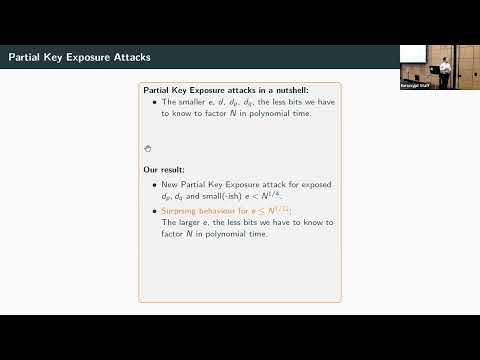CryptoDB
Approximate Divisor Multiples - Factoring with Only a Third of the Secret CRT-Exponents
| Authors: |
|
|---|---|
| Download: | |
| Presentation: | Slides |
| Conference: | EUROCRYPT 2022 |
| Abstract: | We address Partial Key Exposure attacks on CRT-RSA on secret exponents $d_p, d_q$ with small public exponent $e$. For constant $e$ it is known that the knowledge of half of the bits of one of $d_p, d_q$ suffices to factor the RSA modulus $N$ by Coppersmith's famous {\em factoring with a hint} result. We extend this setting to non-constant $e$. Somewhat surprisingly, our attack shows that RSA with $e$ of size $N^{\frac 1 {12}}$ is most vulnerable to Partial Key Exposure, since in this case only a third of the bits of both $d_p, d_q$ suffices to factor $N$ in polynomial time, knowing either most significant bits (MSB) or least significant bits (LSB). Let $ed_p = 1 + k(p-1)$ and $ed_q = 1 + \ell(q-1)$. On the technical side, we find the factorization of $N$ in a novel two-step approach. In a first step we recover $k$ and $\ell$ in polynomial time, in the MSB case completely elementary and in the LSB case using Coppersmith's lattice-based method. We then obtain the prime factorization of $N$ by computing the root of a univariate polynomial modulo $kp$ for our known $k$. This can be seen as an extension of Howgrave-Graham's {\em approximate divisor} algorithm to the case of {\em approximate divisor multiples} for some known multiple $k$ of an unknown divisor $p$ of $N$. The point of {\em approximate divisor multiples} is that the unknown that is recoverable in polynomial time grows linearly with the size of the multiple $k$. Our resulting Partial Key Exposure attack with known MSBs is completely rigorous, whereas in the LSB case we rely on a standard Coppersmith-type heuristic. We experimentally verify our heuristic, thereby showing that in practice we reach our asymptotic bounds already using small lattice dimensions. Thus, our attack is highly practical. |
Video from EUROCRYPT 2022
BibTeX
@inproceedings{eurocrypt-2022-31860,
title={Approximate Divisor Multiples - Factoring with Only a Third of the Secret CRT-Exponents},
publisher={Springer-Verlag},
author={Alexander May and Julian Nowakowski and Santanu Sarkar},
year=2022
}

